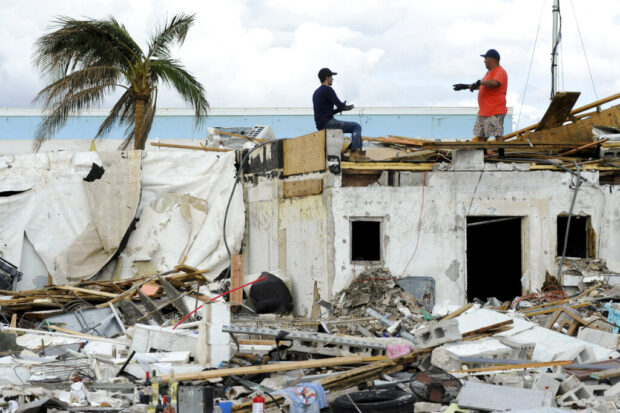Economic losses from natural disasters in 2022 were estimated at $313 billion, with an insurance price tag of approximately $132 billion, according to Aon.
Roughly 42 percent of economic losses were covered by public and private insurance entities, which translates into a global protection gap of 58 percent — the lowest on record, said Aon’s 2023 Weather, Climate and Catastrophe Insight. (The protection gap is the difference between total economic losses and the amount that is covered by insurance.)
Data show that 2022 was the fifth-costliest year on record for insurers, with approximately $50-$55 billion of global insured losses resulting from Hurricane Ian in the United States.
As the second-costliest natural catastrophe in history from an insurance perspective, Hurricane Ian was responsible for about 30 percent of economic and 40 percent of insured losses globally, said Aon, noting that Hurricane Ian is only surpassed by Hurricane Katrina at $99 billion on a price-inflated basis.
While a large part of the global disaster losses remains uninsured, 2022 recorded one of the lowest protection gaps, close to the record year of 2005 when roughly 40 percent of losses were covered. The report attributes the lower protection gap to the fact that both 2022 and 2005 saw extremely costly hurricane events in the U.S., a country with a relatively mature insurance market.
Additional findings in the 2023 Weather, Climate and Catastrophe Insight report include:
- 421 notable natural disaster events were recorded in 2022, higher than the 21st century average of 396.
- 75 percent of global insured losses were recorded in the United States (as a result of Hurricane Ian), which was higher than the average of 60 percent.
- Global economic losses from natural disasters of $313 billion were 4 percent above the 21st century average.
- There were at least 39 individual billion-dollar natural disasters in 2022, below the average of 40.
- Three global drought events – in the United States, Europe and China – were among the 10 costliest disasters, underlining the growing significance of the peril on a global scale. (U.S. and European drought cost insurers $8 billion and $3 billion, respectively, while China’s drought has an insurance price tag of $200 million.)
- U.S. western states continued to experience severe drought conditions, driving crop insurance payouts to their highest level since the historic losses experienced in 2012.
- Windstorm Eunice was the costliest individual European windstorm since 2010, with $3.4 billion in insured losses. Widespread hailstorms in France contributed to the second- highest natural disaster payouts for the country on record of €6.9 billion ($7.4 billion).
- Flood losses floods in Queensland and New South Wales in February and March 2022 resulted in insured losses of $4 billion, the highest loss in the history of the Australian insurance sector.
- April floods in South Africa were the costliest on record for the country, with an estimated $1.8 billion in insured losses.
- Monsoonal floods in Pakistan had a far-reaching humanitarian impact on the country. In a summary of the 2022 monsoon season, the Pakistan Meteorological Department said countrywide rainfall from July to September was 175 percent above average.
- Both severe drought conditions and a prolonged rainy season in different regions of Latin America reduced agricultural crop yield across the region.
Global Fatalities Decline
Approximately 31,300 people lost their lives due to global natural catastrophe events in 2022, which was well below the 21st century average (73,200) and median (38,900), said Aon, noting that roughly two-thirds of these fatalities can be directly attributed to heatwaves that occurred in Europe in June and July.
“The number of annual human casualties has shown a notable decline in recent decades. The improvements in forecasting, evacuation planning and strategies, increased public awareness, and better building practices have all played a key role. Asia, Africa and South America show the greatest improvements with reduced fatalities,” the report said.
“The devastation that disasters caused around the world demonstrate the need for wider adoption of risk mitigation strategies, including better disaster management and warning systems that improve resilience,” said Michal Lörinc, head of Catastrophe Insight at Aon. “While impacts of climate change become increasingly visible around the world, it is the socioeconomic aspects, demographics and wealth distribution that remain a major driver of financial loss.”
Source: Aon
Photograph: Workers talk atop a building that was heavily damaged by Hurricane Ian at Fort Myers Beach, Fla., on Oct. 9, 2022. (AP Photo/Jay Reeves)





















 Artificial Intelligence Is Rewriting the Rules for Commercial Lines
Artificial Intelligence Is Rewriting the Rules for Commercial Lines  NOAA Announces Latest AI-Driven Global Weather Models
NOAA Announces Latest AI-Driven Global Weather Models  Five AI Trends Reshaping Insurance in 2026
Five AI Trends Reshaping Insurance in 2026  Underwriter, Actuary Fears of AI Drop; Work Needed on Collaboration
Underwriter, Actuary Fears of AI Drop; Work Needed on Collaboration 